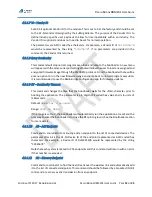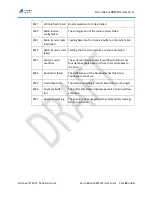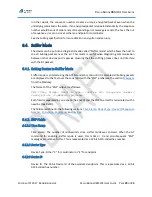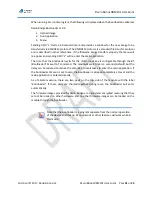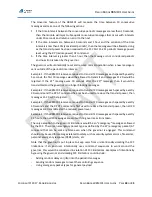
R
ADIO
B
RIDGE
RBM101
U
SER
G
UIDE
C
OPYRIGHT
©
2017,
R
ADIO
B
RIDGE
I
NC
.
R
ADIO
B
RIDGE
RBM101
U
SER
G
UIDE
P
AGE
26
OF
35
6.1.2.
Using Pins to Control Sleep Mode
The following table defines the pins that are used to control sleep mode.
Table 12 Pins used to control sleep mode
Pin
Description
SLEEP_RQ
Sleep request input active high. Pull this pin low to take the device out of
sleep mode and high to request it to enter sleep mode.
ON_SLEEPn Sleep status. Low indicates the device is asleep and high indicates it is awake.
When placing the device into sleep mode, the host must watch the ON_SLEEPn pin to verify
that it has entered sleep mode after completing its current operation. The ON_SLEEPn will go
high any time the device comes out of sleep mode including the periodic wakeup for
supervisory messages, even if SLEEP_RQ is active.
When an endpoint is in sleep mode, the radio is powered off and it cannot receive messages
from a coordinator. In order for a coordinator to communicate to an endpoint, it uses the
periodic wake-up for supervisory messages.
Specifically, the endpoint will wake up automatically in sleep mode to send a supervisory
message back to the coordinator (see the
Supervisor
section), and stays awake for a small
period of time to receive any pending messages that the coordinator needs to send to it.
This window of time is defined by the LW (Listen Window) AT command and is set on the
endpoint. Thus, when a coordinator detects that an endpoint is sleepy, it will send a status
message back to the host to indicate that it has received a supervisory message and the host
can send a message back to the endpoint within the Listen Window.
In order to send a message efficiently within the Listen Window, the coordinator has a QP
(Queue Packet) command available which works like the SP (Send Packet) command with the
exception that it will queue the message and wait for a supervisory signal from the destination
endpoint to send the packet. Only one message can be queued for each endpoint at any given
time, and once it has been sent a status message is returned to the host.
See the
AT Commands
and
Status Messages
sections for more detail.
6.2.
Supervisor Configuration
The purpose of the supervisor is to provide periodic messages from each endpoint to the
coordinator to indicate it is still alive and operational.
6.2.1.
Supervisory Messages Period
The period of the supervisory messages defaults to one hour but can be modified through the
ST (Supervisor Timeout) AT command. When the timeout (or period) is set on an endpoint,

